“How sweet I roam’d from field to field,
And tasted all the summer’s pride,
‘Til I the prince of love beheld,
Who in the sunny beams did glide.”
William Blake
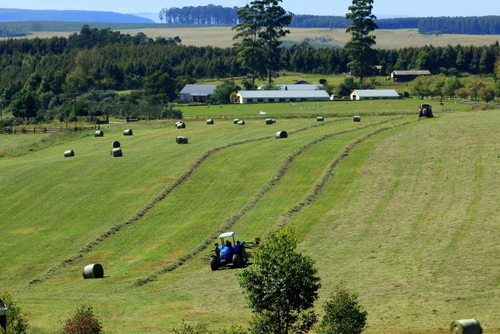
To say we have had little to cheer about over the last few years would be an understatement. As a political cartoonist, whose jobs involves trawling through the daily news headlines looking for somebody or something to lampoon, I can safely vouch for this. Faced with the endless litany of woes – climate change, Covid-19, lockdown, a collapsing economy, state capture, rampant crime, decaying municipalities, crumbling infrastructure and corrupt, venal, and singularly inept politicians – it is often very difficult to see the funny side of it all.
In my doubting mind, it sometimes feels like I will never escape the dark shadows closing in on me on all sides.
But there is hope even if it is fleeting and ephemeral. A country mouse at heart, I continue to search for and find solace in nature and simple delights. Don’t get me wrong! I am well aware that my love affair with the wilderness may not be reciprocated and that it includes a degree of anthropomorphism, the great bogey of science.
That doesn’t stop it from having meaning for me. I see no need to expunge these feelings from my interaction with nature.
I don’t have to go far to look for this alternative world. Since I moved up to Kusane Farm and started planting lots of indigenous trees and bushes and flowering shrubs – my contribution to saving the planet– I have gathered a flourishing population of birds and other wildlife in my garden.
Every morning the Village Weavers gather in noisy, scraggly groups at the bird feeder. They are, in turn, joined by several varieties of sparrow, pigeons and doves. Plus, in summer, the very tiresome, testosterone-loaded male Pin-tailed Whydah who makes a nuisance of himself by trying to drive all the other birds away from the food table – just so he can claim it for his wife (in winter he loses his beautiful plumage and his stroppy attitude and becomes a submissive little nobody you barely notice).

Cape Sparrow 
Grey-headed Sparrow. 
Pin-tailed Whydah in breeding plumage
As part of my daily routine, I also put out a little grated cheese on a rock that brings in the Red-winged Starlings, the Cape Robin, the Cape Wagtail, the Southern Boubous, the Black-capped Bulbul, the Olive Thrush and the Speckled Mousebirds. In winter, I sometimes add a little Jungle Oats porridge to go along with it, just to warm them up.
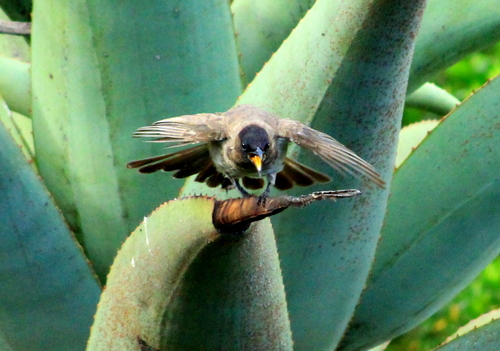
Darked-capped Bulbul demanding food.. 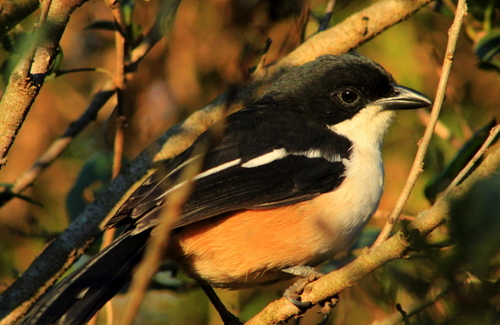
Southern Boubou (male) 
Cape Robin 
Red-winged Starling (female) breakfasting on Cheddar cheese and Jungle Oats…
The news about the easy pickings has swiftly spread and other birds have started pulling into my roadhouse. A much-welcomed newcomer has been the Sombre Greenbul. Its name is something of a mystery to me for its call (described by SASOL Birds of Southern Africa as “a piercing ‘weeeewee’, followed by a liquid chortle…”) is one of the most cheerful you will hear. Colour-wise it is perhaps a little on the drab side but no more so than a host of other dull-coloured birds. Preferring to call from deep within the canopy of a tree, it is a bird you hear more often than see.
It has been joined in recent months by a Dusky Flycatcher, a tiny bird with the typical flycatcher behaviour of making short dashes up into a cloud of gnats or other flying insects before returning to its favourite perch. Endearingly happy little characters they can, over time, become quite tame.
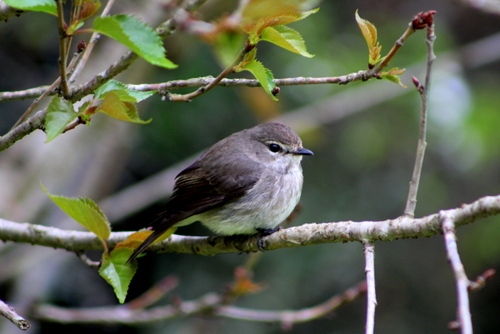
The large corrugated-iron barn I live in has also provided the right sort of habitat for a host of other birds to call home. In the cold weather, the Rock Pigeons like to sit and warm themselves on the pipes that lead to the solar panel and geyser on the roof (they also nest in the rafters). Wagtails strut past them, tails endlessly bobbing. The sparrows make a home in all the nooks and crannies. In summer our resident pair of Greater-striped Swallows like to sit on the railings and twitter away, especially just before they are about to undertake their perilous journey North.

Rock Pigeon on balcony 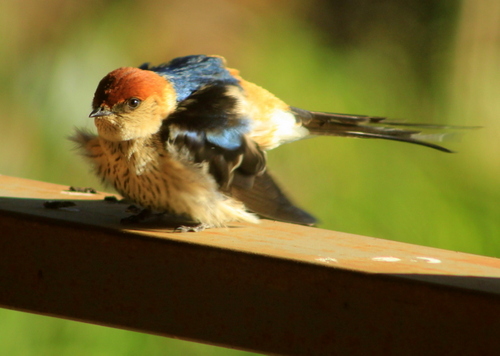
Greater-striped Swallow on balcony
For the last three seasons, I have also had an Amethyst Sunbird nesting on the Air Plant which hangs on my balcony. I feel a distinct sense of triumph that it has elected to live and raise its family with me. I like to think of it as a blessing from the gods, a portent of happiness (that’s me getting all anthropomorphic again!)

Amethyst Sunbird chick 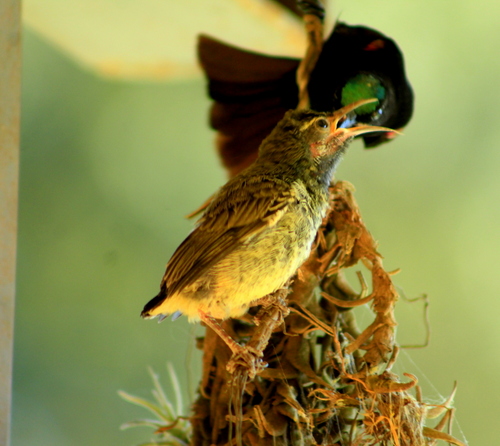
Chick being fed by male parent
The beautiful Malachite Sunbird is the other common sunbird in my garden, especially in winter when the aloes I planted are in bloom. This dashing, shiny bird often chooses to sit on some prominent point from where it twitters happily away while keeping a sharp eye out for any rival male which it will quickly chase off.
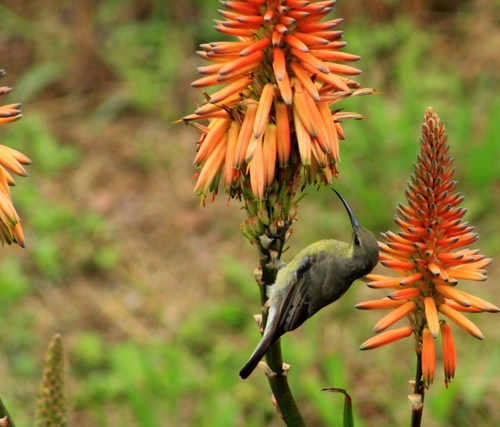
Malachite Sunbird (female) 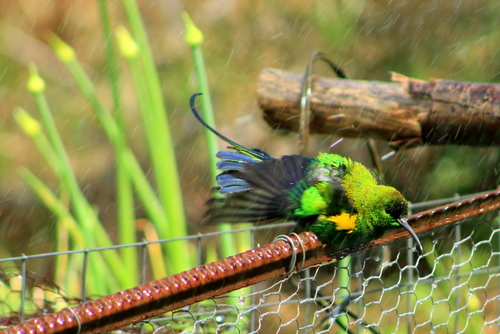
Malachite Sunbird (male) in breeding plumage
My birding is not, of course, confined to the garden. I have several particular patches of ground I like to visit regularly throughout the year.
Today, I elect to head down the familiar route that takes me through our front gate and past the house with the gumtrees and horde of barking dogs. At the next gate, I come to, just past the cattle crush and sorting pens, I take an abrupt left turn down Nicholson Highway. Despite the name we have bestowed on it, is not a highway, just a nondescript, muddy, farm road that leads through a large, cow-inhabited, rectangular field to a slightly better maintained road on the other side.

The big field slopes upward, South to North, from the old stone wall built by the Italian POWs during WW2 for purposes unknown – other than giving them something to do, I suppose. At the top of it, one has a breathtaking view over the entire Karkloof Valley with its regularised grid of big fields, forests and dams. The very distinctive, leonine-shaped Loskop and the purple-tinged Karkloof hills provide a suitably dramatic backdrop to this ever pleasing vista.
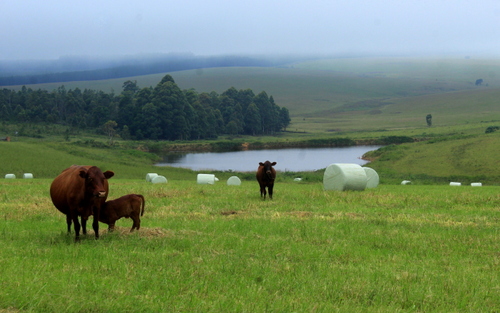
The Field, looking South with mist drifting in. 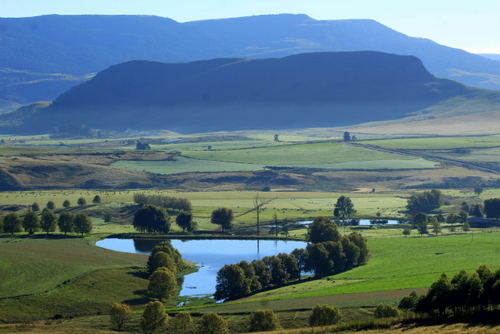
Looking North over Karkloof Valley.
There are subtle changes here, every day and every season. Close your eyes in summer and you could almost imagine you are in Ireland because of all the vibrant greens, low scudding clouds and mysterious mists. In winter, when the fields are covered in stubble and the colours are more subdued, there is a stark, minimalist beauty to the landscape.
As I enter the field, via Nicholson Highway, I scan the grass with my binoculars. A bird flies up calling, a plaintive, drawn-out ‘wheeee…’ It is the appropriately named Wailing Cisticola. A little further on I see another Cisticola. A smaller one with a slightly fanned-out tail. It is known as the Zitting (formerly Fantailed) Cisticola because – you guessed it – of the ‘zit’ it makes at the crest of each undulation during its display flight…

Zitting Cisticola 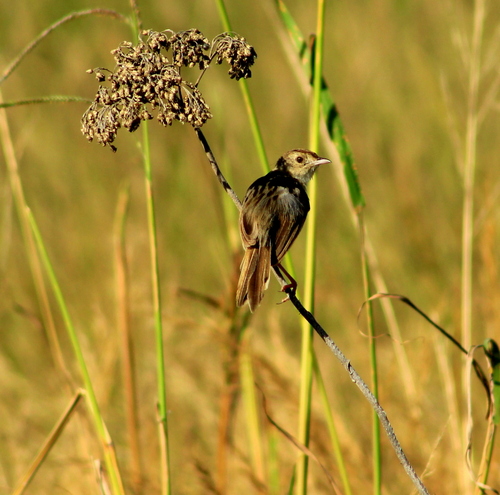
Wailing Cisticola
It is open country here and – I suspect because the cattle who sometimes graze here provide good manure – the grass is longer and more luxuriant than our wiry, unpalatable, stuff next door. Because of this, it has become a haven for grass-loving species. They like it because it has ground cover and it has food.
My alternate name for Nicholson Highway is Longclaw Lane because this is very much their kind of country (the Yellow-throated is our common Longclaw). The bird’s plaintive, fugitive call, as it lifts into the sky, always sets my veins a-tingle. Likewise, several varieties of the Pipit have staked their claim along the road. I have seen both African and Plain-backed on many occasions.
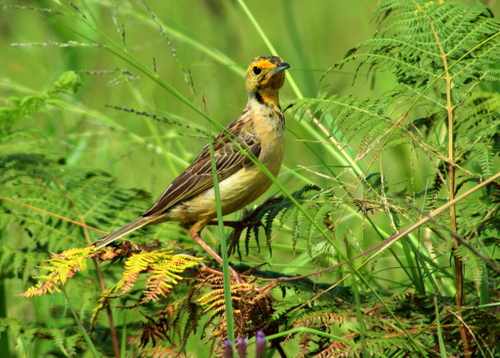
Yellow-throated Longclaw 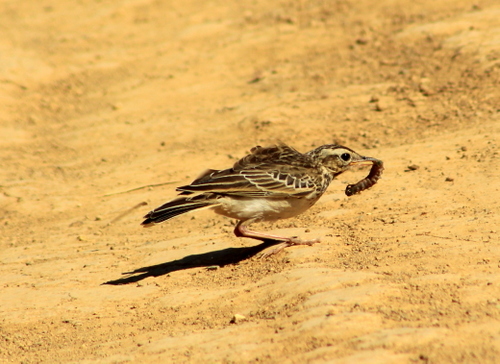
African Pipit
Happy to be out in the sun, I stand still a moment taking in the sounds. On the edge of the field, amongst the bramble, I hear the raucous screeching of a pair of Natal Francolin, followed by a clattering of branches as a flock of Rameron Pigeon take off, heading to their daily feeding grounds. Further up, on the crest of the ridge, the Black Crows squabble and exchange insults in the line of fir trees where they like to roost.
Next, I look up and see two Blacksmith Plovers calling as they fly overhead. Elsewhere, swallows and swifts and martins zoom around imaginary corners in pursuit of meals you and I can’t see. Closer to the ground, a party of widow birds, all piping excitedly in chorus, follow each other around in small, swooping circles.
Today, the cross-sky traffic includes a raptor gliding in the thermals. South Africa has a wide variety of raptors. Each of these raptors are charismatic in their way. The common one, where I live – the bird I am looking at now – is the Long-crested Eagle. It is so named because of its stylish, protruding headgear. You often hear this eagle’s high-pitched call before you see it, high above.
The sky is not the only place it likes to be. People may complain about the unsightly poles that run along our country roads (especially where the cut wires now hang unused and useless) but some birds love them. The Long-crested is one such bird. The Jackal Buzzard another. The poles provide a much-favoured Observation Point from which to scan the surrounding countryside for food.

Jackal Buzzard 
Long-crested Eagle
Widely but locally dispersed across South Africa, the Secretary Bird makes the odd stop-over in the field. Taking its name from the long, quill-like, feathers protruding from its head, the Secretary bird is, in fact, an eagle with very long legs. It puts these legs to good use. My battered old copy of Roberts Birds of South Africa describes this succinctly: “After landing runs for some distance with wings outstretched. Snakes are attacked with violent blows from the feet while the wings are held outspread as a shield. Great care is taken to make certain the snake is dead before it is swallowed, whole if it is small...”

In the past, the field has yielded some other surprises. Bustards are very shy and wary, so it is a privilege to encounter them anywhere in the wild. You can imagine my excitement, then, when I came across not one but THREE Denham’s Bustard, feeding in the upper end of the field. The Denham’s is the second-largest bustard in South Africa (prime honours go to the Kori Bustard, the largest flying bird in the world) and is listed as NEAR THREATENED.
Cranes are equally rare across the world so I also consider myself lucky to have seen all three of the South African species (the Wattled, the Grey-crowned and the Blue), at various times, here. They are special. Stately, regal and a little otherworldly, their elegant courtship rituals are one of the great wildlife spectacles.

Grey-crowned Crane 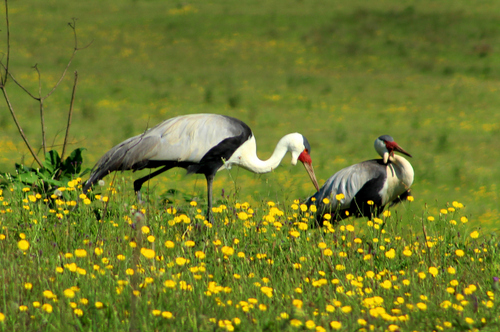
Wattled Crane
Having made a mental count of all the birds I have seen so far, I continue down the winding road until it comes to a T Junction. On the opposite side, in a paddock, a couple of horses are being put through their paces at the local riding academy. Another noisy dog lives here too. A big black one. We didn’t hit it off when we first met so I prefer to avoid it.
I accordingly turn and follow the fence line down to a farm dam (and away from the big, black dog). The grease-gleen of the early morning sunlight glitters romantically on its water, as three dabchicks create patterned artworks as they swim away from me towards the far shore. A large White-breasted Cormorant lifts itself out of the water and flaps noisily off. The Blacksmith Plovers, I saw earlier, are now patrolling the edge of the water. As soon as they see me they give their characteristic loud, ringing, metallic ‘tink, tink, tink’ alarm call, from which they derive their name.

Dabchicks 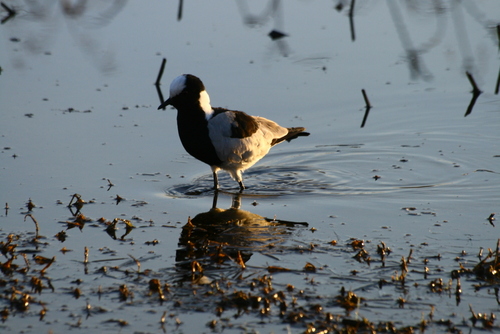
Blacksmith Plover
They don’t seem to want me around either. They are not alone in their antipathy.
On the far side, partly concealed in the long grass, a pair of male reedbuck follow my movements with worried eyes. An uninvited intruder in their private domain, not wanting to scare them, I high tail it along the dam wall, hoping they won’t take fright. They retreat a little further up the inlet but don’t runoff.

There is another panoramic view from the wall, one that shows more dams and more fields full of hay bales and groups of contented cows grazing on the sloping hillside you look across to. In winter frost often clenches the ground below the wall, the relentless summer rain can turn it into a muddy quagmire in which animals get stuck.
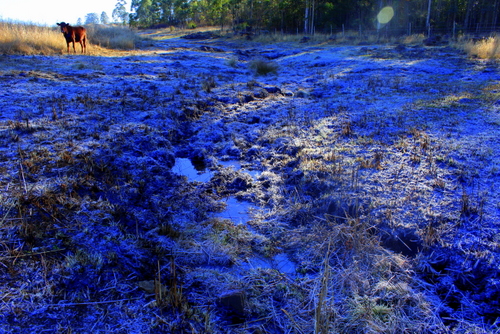
Once over the wall, I follow the now faded path that leads back to our side of the field. The path used to lead to a farm shebeen on the next door property but that was closed down for security reasons.
Although now cropped low, the grass is still plentiful at this end of the field. At certain times of the year, there are eruptions of flowers amongst it which draw the insects in. Bees and flower-visiting wasps buzz about. Butterflies too. For three days, two-years ago, this area was alive with flickering wings as the annual midsummer migration of the thousands upon thousands of Brown-veined White Butterfly (also known as Pioneer Caper White) took place.
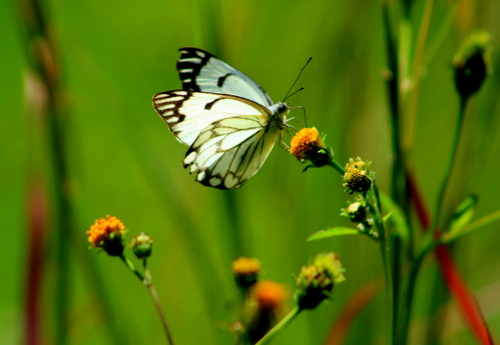
Brown-veined White Butterflies… 
The distance these tiny creatures cover on this epic trek (depending on climatic conditions their numbers vary each year. This year it didn’t seem to happen or, if it did, I missed it) are mind-boggling. Starting on the cold shores of the South-west Cape, they fly as far as sub-tropical Mozambique.
Walking along the fire break that leads back home I keep my eyes peeled. I have seen Serval here twice before, returning home from a night out hunting. I don’t see one today but it doesn’t bother me. The fact they are so seldom spotted only adds to their mystery and allure.
For the rest, I am happy to just be wandering along this path, enjoying this small moment of fleeting time. Out here I can get a kind of feeling of belonging and recognition, a level of engagement, a sense of purpose, an appreciation of beauty that has absolutely nothing to do with the latest news stories or the world beyond these hills.
And for that, I feel blessed…
Thank you for this. Positive glimpses into the natural world are therapy for the human evils so current today. Best wishes, Graeme
LikeLike
Thanks, Greaeme. I have deliberately tried to avoid dwelling on the negative in my blogs (apart from my cartoons of course) so good to hear…
LikeLike
Beautifully written Stides and so true
LikeLike
Thanks, Mary Ann. Glad you enjoyed it.
LikeLike
Your way with words,makes learning about our feathered friends, so much easier.
LikeLike
Thanks, Hugh. I am keen to win converts to my birding cause!
LikeLike